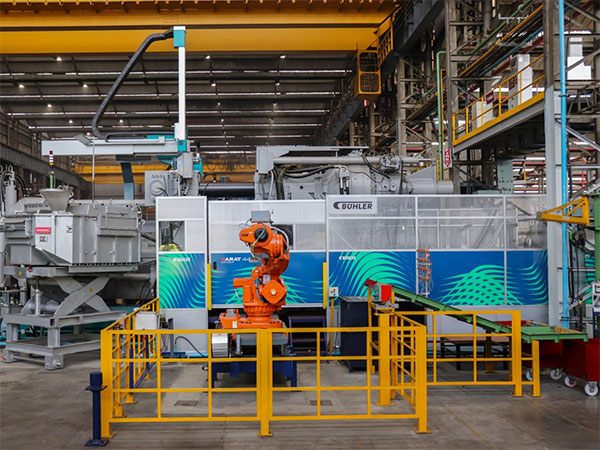
The turnover of pharmaceutical industry in India reached Rs 4,17,345 Cr in 2023-24, registering a growth of 10% over 2022-23
Nov 26, 2024
VMPL
New Delhi [India], November 26: The pharmaceutical industry in India is currently valued at $50 Bn. India is a major exporter of Pharmaceuticals, with over 200+ countries served by Indian pharma exports. India supplies over 50% of Africa's requirement for generics, 40% of generic demand in the US and 25% of all medicine in the UK. Hailed as the "pharmacy of the world", the booming pharmaceutical industry of India is a leading source of cutting edge innovation especially when it comes to providing life-saving medicines at affordable prices to people. Presently, it's the largest international provider of generic drugs, which are the cheaper- but similar medicines as brand name medicine.
What is Generic Drugs?
Generic drugs can be defined as affordable versions of branded drugs which are brought into the market once the original drug manufacturer's patent expires. These medicines have the same potency, quality, and implications and work in an identical manner as the branded drug. The generic medicines are marketed either by a salt or brand name.
Indian Scenario
As India's population grows, especially the aging population has significantly increased the demand for generic medicines on account of their affordability and effectiveness, which is same as branded medicines. The low cost of generics is an alternative to branded drugs and hence generics dominate, making up for 70 to 80% of the retail market. According to study, the Indian generic drugs market stood at USD 24.53 billion in 2022 and is expected to grow at a steady compound annual growth rate (CAGR) of 6.97% during the forecast period. The regulations governing the approval of generic drugs are somewhat the same world over, with very few differences in developing countries, as in this part of the world it is not mandatory to undergo bioequivalence (BE) studies for getting approval for generics, and the gold standard considered for regulation in this field is United States. In 2008, the Government of India, through the Department of Pharmaceuticals, started a new initiative "Jan Aushadhi" (Medicine for People). This program envisaged making unbranded quality medicines available to poor people in the country at a reasonable and affordable price through retail outlets' setup with the help of the government. It has taken ownership of setting up Jan Aushadhi stores, which are pharmacies selling only generic name medicines to the extent possible, giving preference to pharmaceutical public sector undertakings too. There are not enough Jan Aushadhi stores, possibly 3200 against more than 8 lakh retail pharmacies in existence, with many rural areas still underserved.
Quality Issues
Generic medicines are typically 30%-80% cheaper than originator equivalents. The question raised quite often is "Whether the quality and performance of generic drugs is comparable to the brand drugs?" The proponents of generic drugs claim that they are equally effective as brand or innovator drugs. Subsequent to this claim, the Drugs Technical Advisory Board of India in May 2016 considered amending Rule 65 (11A) of the Drugs and Cosmetics Act, 1940, so that pharmacists can dispense generic name medicines and/or equivalent brands against prescriptions in brand names. However, skeptics have stated that the use of generic drugs may lead to prolongation of illness or even therapeutic failure as the bioavailability (BA) of a generic drug may not be as good as that of the prescribed brand. Hence, the critical issues that affect the quality of generic drugs are purity, potency, stability, and drug release, and these should be controlled within an appropriate limit, range, or distribution to ensure the desired drug quality.
Road Blocks & The Challenges
One of the main reasons for lack of confidence in generic drugs among doctors (and even patients) has been the absence of stringent regulatory requirements for the quantity of the drug in its generic version and the permissible impurities in it. Illegitimate drugs have been a challenging issue for India over quite a period of time. In 2018, the Central Drug Standard Control Organization (CDSCO) identified nearly 4.5 per cent of all generic drugs circulated in the domestic market to be substandard. Meanwhile, the issue begins with the lack of quality testing facilities across the country. Drug control procedures in India suffer from the lack of fund, resources and manpower and hence make matters worse. Another issue is with the counterfeit medicines sellers who operate at the retail level and procure the substandard medicines from dubious suppliers. Also, many fraud chemist shops sell the counterfeit drugs illegally using the name of a pharmaceutical company that remains completely unaware of the incident. While fighting this issue is beyond the scope of a pharma company, it is very important that it is stopped immediately since it ruins the reputation of that particular pharma company. To ensure that the quality of generic drugs is equivalent to its branded version and that this equivalence is scrupulously maintained, the government should also bring legislation to ensure compliance in generic drug manufacturing and testing.
The way forward for India
Experts who formulate medical education curriculum would have to address this lacuna to ensure that future practicing physicians are well versed and comfortable in prescribing generic drugs. Pharmacies and drug stores other than in government-run hospitals and clinics hardly stock unbranded generic drugs. Healthcare expenditure continues to rise in countries where healthcare is not a priority. Healthcare providers and policymakers need to keep drug prices affordable. Generic drugs offer an important tool for reducing the overall healthcare expenditure. As more and more patents expire, the generic versions of the pharmaceutical market are expected to continue for increased sales. If sponsors, healthcare providers, and regulators work together effectively, then effective use of generic drugs will make medical costs cheaper and also ensure sound treatment options for the patients. Meanwhile, a generic medicine must obtain Food and Drug Administration (FDA) approval for prescription and consumption.
In developing countries like India, government bodies and other regulatory bodies have pushed manufacturers to launch effective generic drugs supporting pharma market growth. The introduction of 3-D printing technology helps in manufacturing generic medicines with varying release dates and tastes and has pushed the share of generic drugs in pharma industry. The short expiration and gap between re-filing of the new drug encourages various companies to produce generic drugs owing to rise in competition which further reduces the generic drugs prices. Several initiatives are undertaken by government bodies towards awareness of the availability of generics like Pradhan Mantri Bhartiya Janaushadhi Pariyojana (PMBJP) under which PMBJP Kendras across the country will make quality generic drugs and implants accessible at affordable prices.
Conclusion
Generic medicines are low in cost but as effective and safe as branded medicines. In India, it is being widely used, the PMBJP aims to spread more awareness among people. Also, the pharmaceutical industry has shown tremendous progress and adapted to a changing environment which will help in achieving more success in generic drugs export from India.
(ADVERTORIAL DISCLAIMER: The above press release has been provided by VMPL. ANI will not be responsible in any way for the content of the same)






